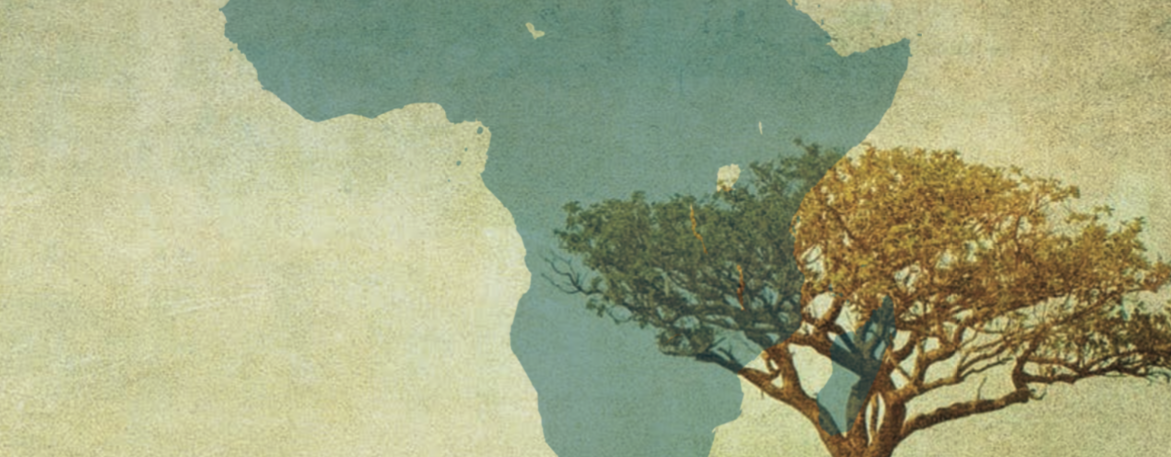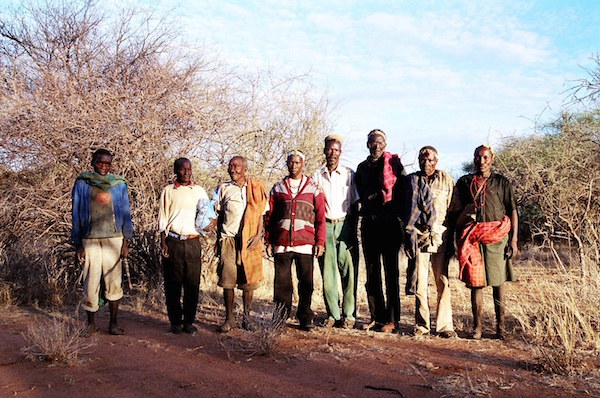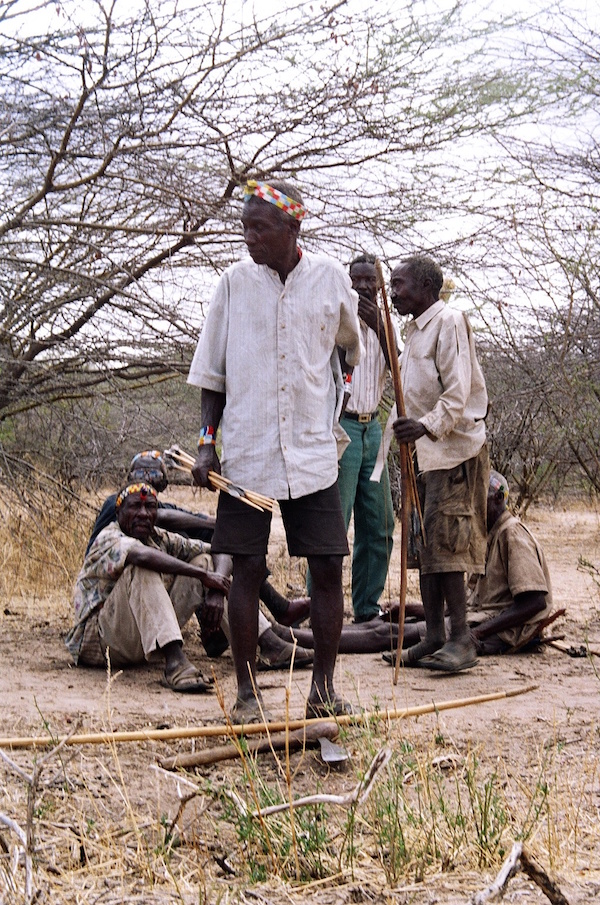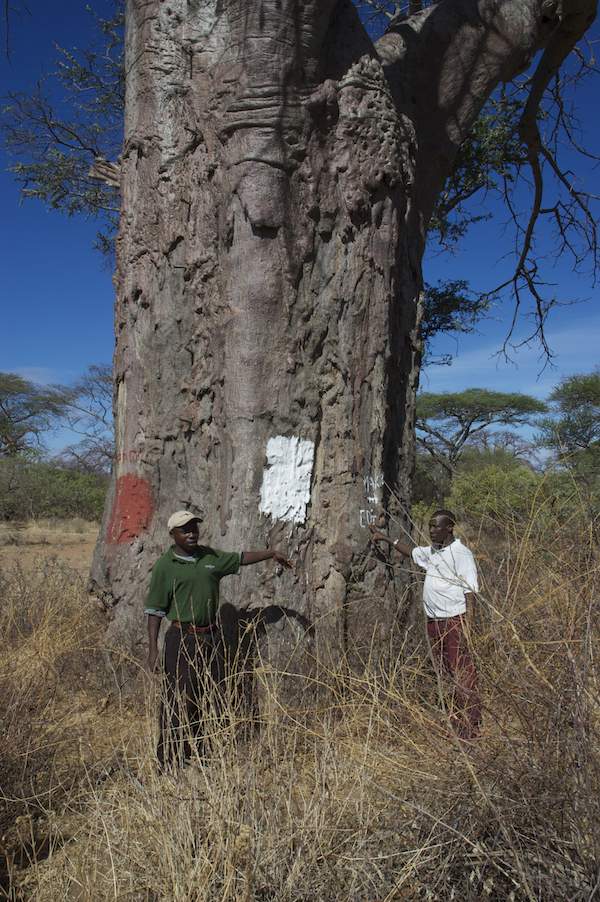
The following case study is an extract from Protecting Community Lands and Resources in Africa, a book of case studies that highlights land rights advocates’ innovative community land protection efforts.
By Edward Loure and Edward Lekaita, Ujamaa Community Resource Team (UCRT)
The Ujamaa Community Resource Team (UCRT) has been working for over a decade to address the land rights and related natural resource management issues of roughly 40 pastoralist, agro- pastoralist, and hunter-gatherer communities across northern Tanzania. UCRT assists these indigenous communities to secure rights to their lands in order to access, manage and benefit from their natural resources, while simultaneously conserving their environment for future generations. This effort requires a multi-pronged approach that builds capacity for collective action on multiple levels, from the individual household to national policy-maker. Some of the approaches utilized by UCRT include land demarcation and boundary reconciliation processes, mapping, village registration, certifying land occupancy, and facilitating the development of land use plans and community by-laws. UCRT has also played a lead role in enabling local communities to build linkages with external sustainable development, tourism investment, and wildlife conservation interests.
UCRT develops its programs in full collaboration with local communities in order to ensure community ownership and program sustainability. We believe that all members of a community deserve an equal right to participate and make decisions regarding community affairs, and that decisions should not be undermined by elites or vested interests. To achieve this vision, UCRT avoids political involvement and gives communities enough room to interact on agendas and develop joint resolutions before moving forward with any project. In this way UCRT has developed strong and close relationships with target communities.

Hadza community members take UCRT staff members out on the land to demonstrate and document their traditional knowledge of the landscape. © UCRT
Historically, pastoralists and hunter-gatherer communities in northern Tanzania have faced severe encroachment and loss of their traditional lands to a number of external entities. They have lost large portions of their homelands to the creation of national parks and other conservation and tourism interests, to commercial agricultural and ranching schemes developed by the government and investors, and to illegal land-grabbing schemes carried out by local and national elites. As land shortages in Tanzania become increasingly acute, and investor interest rises in sectors such as biofuels and agriculture, threats to indigenous lands and livelihoods are intensifying.
Tanzania began a process of land reform in the 1990s to address some of these issues. The Village Land Act of 1999 was intended to delegate land control to local communities through the establishment of village councils and land use plans. However, while the Act dealt extensively with the land rights of Tanzania’s numerous agricultural and pastoralist groups, the rights of hunter-gatherers were not mentioned. Additionally, there has been no mention of hunter-gatherer communities in any contemporary Tanzanian law. This has created obstacles in trying to assist these communities to define and secure their rights over those of dominant neighboring tribes. Moreover, later legislation such as the Wildlife Conservation Act of 2009 threatens the very survival of the hunter-gatherer community by criminalizing hunting without a license.
The Hadzabe are one of only two hunter-gatherer groups remaining in Tanzania that have not yet lost all of their lands and culture to dominant neighboring agricultural and pastoral communities. They reside in the Lake Eyasi basin of northern Tanzania, adjacent to Serengeti National Park and the Ngorongoro Conservation Area, and number about 1,500 individuals. Because the Hadzabe depend on hunting and gathering for a significant portion of their subsistence needs, they have institutionalized mechanisms within their culture to maintain a healthy natural environment with sustainable land use.
The Hadzabe was one of the first communities that UCRT began work with after it was founded in 1998, as the organization’s vision was to assist hunter-gatherers and pastoralists to improve their livelihoods and the Hadzabe were the largest group of hunter-gatherers in Tanzania. At that time, a majority of the community lived in Mongo wa Mono village. The land of the village is traditional Hadza land but it had been encroached upon by agricultural and pastoralist communities from other parts of the country. As mandated by the Village Land Act, a village council was elected to determine the boundaries of village land and control local land use planning. The Hadza did not participate in these local elections because they maintained their own traditional governance structure separate from the village, and neither understood their rights nor realized the full extent of control the Village Council would have over their affairs once elected. Ultimately, this resulted in a lack of Hadza representation within local governance, and subsequent loss of control over their lands to outsiders when the Council designated zones for various land use purposes throughout the area without prioritizing Hadza interests. Without adequate access to hunting and gathering grounds, the Hadzabe were unable to practice their cultural traditions or customary methods of subsistence.
This is the situation UCRT found upon first entering the village, and began engaging in civic education and developing the community’s capacity to strengthen internal governance. For several years UCRT also negotiated with the Village Council to set aside land strictly for Hadza settlement and hunting and gathering activities in their land use plans. The Council finally agreed to do this in 2003, but no legal documentation secured the oral agreement. Thus the local government was free to revise the land use plans at any time, and lands designated for Hadza use continued to be redistributed to non-Hadza users. As migration to the area continued and the Hadzabe increasingly became a minority population within their own village, it was clear by 2004 that the Hadza needed a further step to secure their land tenure.

Hadza men prepare traditional hunting equipment during a cultural event. © UCRT
UCRT called a Hadza community gathering and explained the process of obtaining a Certificate of Customary Right of Occupancy (CCRO), the primary means of securing collective rights under the new land laws of Tanzania. The Village Land Act prescribes that an individual or group living on customarily held lands over 250 hectares in size may apply for a CCRO from their local Village Council with the approval of the Commissioner of Lands. The application process requires that the local council define and approve community by-laws, receive a certificate of village land, and agree on boundaries and land use plans through a district-level demarcation and zoning process. Upon approval, the CCRO provides permanent tenure to the holder. The Hadza community agreed via consensus to move forward with this approach because it would mean that the village government would no longer have the power to undermine Hadza land rights.
The Hadzabe faced several obstacles in attempting to obtain a CCRO. Despite the stated purpose of the legislation, the CCRO process had only been utilized by individuals and corporate entities to obtain land tenure prior to the Hadzabe application, and the central government was unsure how to approach a community-based application for the first time. Additionally, the legislation requires that group applicants either be registered as a legal entity, or be recognized as a formal group under customary law.
The Hadzabe were not interested in registering as a legal entity for two reasons. First, the community wanted their land rights secured as quickly as possible, and the registration process was complex and time-consuming. Second, the process of registration would require the Hadzabe to replace their traditional leadership system with state-mandated institutions and procedures that did not necessarily fit with their modality of life. Additionally, proving that the Hadzabe were a formal group under customary law was difficult, because as mentioned above, hunter-gatherers had never been addressed in Tanzanian legislation, and government officials were largely ignorant of the community’s existence. It was up to UCRT to negotiate a streamlined CCRO process that would allow the Hadzabe to secure their lands while also retaining their unique lifestyle and traditions intact.
UCRT had already been involved for some time in the lengthy process of mapping, zoning and demarcating Hadzabe land with village and district governments. Now UCRT also began holding a series of discussions with the office of the Northern Zone Assistant Commissioner for Lands in Moshi. The negotiations were long and difficult due to the complicated requirements demanded by the Ministry of Lands and the government’s general lack of understanding regarding the customs and institutions of the hunter-gatherer community. For example, it was necessary for UCRT to explain to the government the difference between the community’s practice of hunting on their own lands for subsistence and cultural purposes and poaching for entertainment purposes as practiced by commercial hunters on lands they have no connection to.
It was also challenging for the government to accept the nature of the community’s leadership institutions, as the Hadzabe are an egalitarian society that makes decisions based on consensus by the entire group rather than maintaining a system of organized hierarchy. This was not an officially recognized form of governance that the Ministry was comfortable entrusting with land management and ownership rights. UCRT addressed this concern by arranging a compromise between the community and the government. The Ministry would put the certificate of ownership in the community’s name collectively, but the Hadzabe would need to select several respected leaders to be appointed as trustees and held legally accountable for land management. This way, the community develops a new mechanism to interact with the government’s administrative system while maintaining its traditional self-governing institutions intact.
The turning point finally occurred when the Assistant Commissioner was convinced to visit the Hadzabe in their homeland in order to view their predicament firsthand. The community welcomed her with traditional song, dance and food, followed by public presentations on their experiences and endeavors. They showed her their ancestral lands and explained their cultural and spiritual attachments to various locations and natural resources as well as the hardships Hadzabe have suffered as a result of dispossession. The Commissioner was moved by this experience and committed to assisting the community with their land claim.
After several years of negotiations back and forth, the Assistant Commissioner and District government finally acknowledged the Hadzabe for their uniqueness in 2011 and granted the community a Customary Right of Occupancy for as long as they continue to exist. Three certificates of land were issued for an area of 23,000 hectares that includes two villages, Mongo wa Mono and Domanga, and allow Hadzabe from both villages to use any of the areas. Restrictions on land use are based on the zoning previously determined by UCRT, the Hadzabe and the Village Council: certain areas are zoned for settlement and grazing, while a large portion is retained purely for hunting and gathering activities. This is the first legal certification of land granted to a hunter-gatherer community in Tanzania, and creates an opportunity for other indigenous groups to secure their land tenure through the same process.
With support from The Nature Conservancy and Norwegian People’s Aid, UCRT organized a celebratory meeting between Hadzabe from the three villages of Mongo wa Mono, Domanga and Mangola later that year. UCRT invited the Land, Legal and Game Officers from the Mbulu District Council to help facilitate alongside three teams of UCRT staff. The six-day meeting brought together more than 150 participants, 67 women and 83 men, and made it possible for Hadzabe from across the region to discuss a number of issues as a group, including:
During the meeting, the community agreed to appoint local scouts in order to increase security of their newly certified lands. The community assembly selected thirty Hadza youth to patrol the area and protect their boundaries from encroachment. Any intruders will be reported to the District Council, which can authorize police to enforce local land use plans and by-laws.
The Hadza also gained new economic opportunities as a result of obtaining their CCRO. Now that they are the recognized owners of their land and natural resources, they are able to participate in conservation programs with Carbon Tanzania, for example, wherein revenue from the sale of certified carbon offset credits is paid to community members for managing the conservation of their forest areas. A percentage of this revenue has already been paid to the local scouts for enforcing Hadza land use plans.[1] Other opportunities have since emerged for the Hadza in collaboration with local eco-tourism initiatives.

Hadza community members describe a cultural site
to UCRT staff during cultural mapping of their traditional lands. © UCRT
Securing land tenure for the most vulnerable members of society often requires a multi-faceted approach that blends formal legal processes with negotiation strategies. In this scenario, it was necessary for UCRT to broker communication and cultural differences between the Hadzabe community and several layers of government leadership from the Village Council, District Council, and the Ministry of Lands in order to bridge the divide between official decision makers and those whom the decisions affect on the ground. Building relationships with individuals at each of these levels was key to the success of this process. Also essential was creating a sense of personal responsibility amongst government leaders by physically introducing them to the community members involved and showing them the physical and cultural losses at stake.
UCRT would encourage civil society organizations and activists working for hunter-gatherer communities not to lose hope, but to continue to lobby and advocate for their rights. The livelihoods of indigenous communities are extremely different from those of mainstream groups and it can be quite challenging to find existing legislation or policy in their favor. However, it is possible both to create relationships with individuals in existing institutions in order to find alternative solutions to address indigenous concerns, as well as to push for the creation of new legislation and institutions to provide legal protections for these rights. In this respect Tanzania is reaching a milestone, as the proposed Constitution currently awaiting referendum approval now includes express provisions on hunter-gatherer protections. Constitution-making is a political process that requires numbers in order to win rights, but our consistent lobbying and advocacy work over many years has resulted in recognized, legalized rights for hunter-gatherers for the first time. The journey can be very long and with numerous challenges, but success is possible
[1]Anderson, J., Baker, M. and Bede, J. 2012. Reducing Emissions from Deforestation and Forest Degradation in the Yaeda Valley, Northern Tanzania. Carbon Tanzania and UCRT. http://www.planvivo.org/wp-content/uploads/Yaeda-REDD-PDD-published.pdf